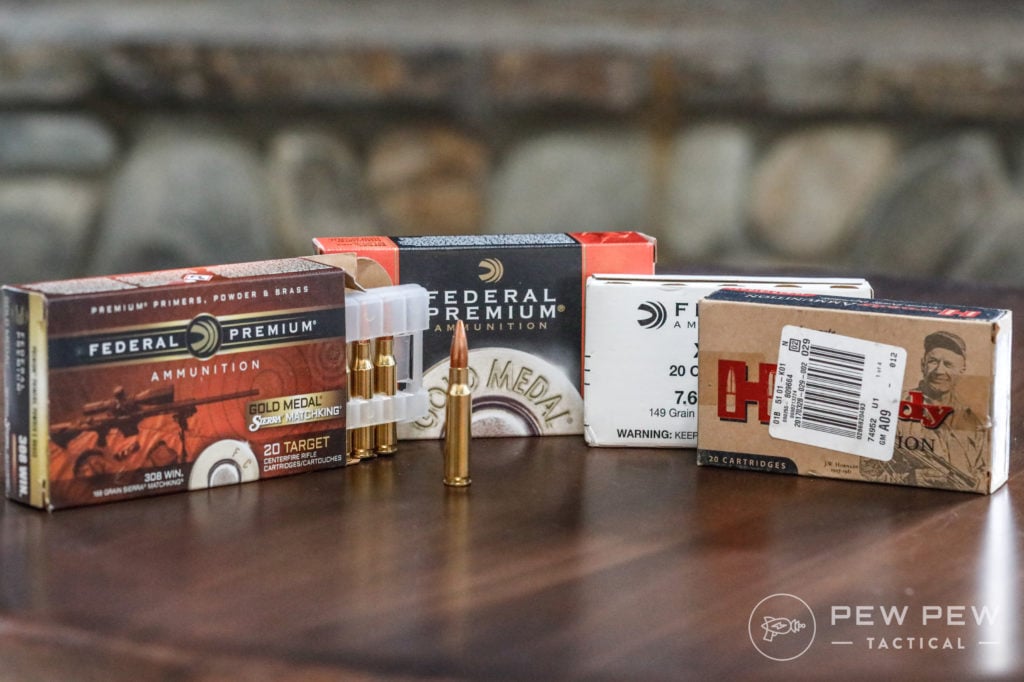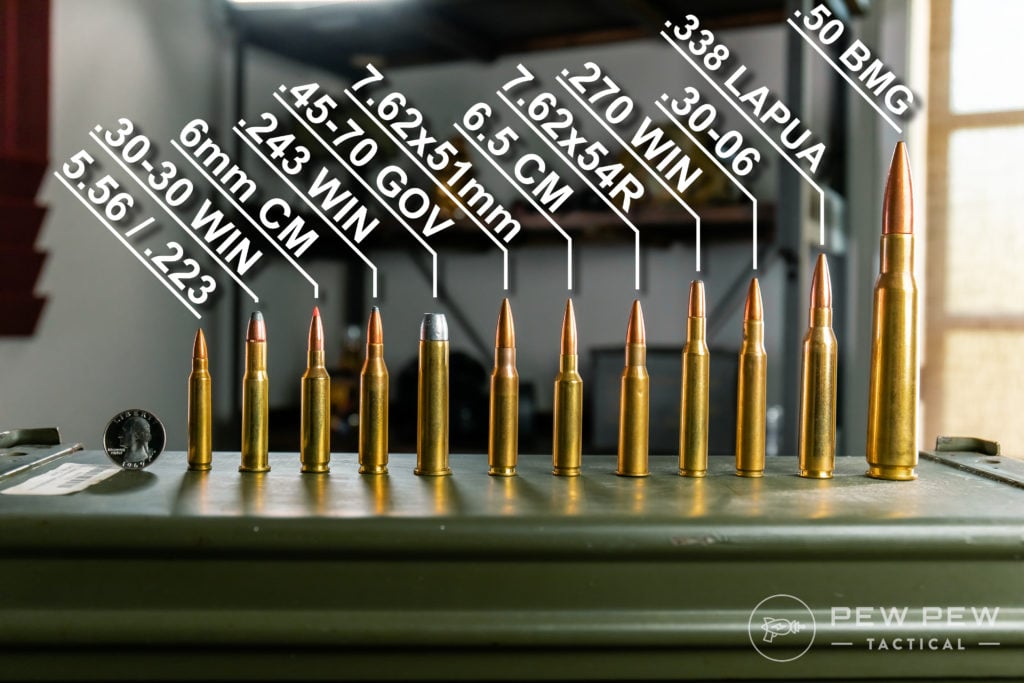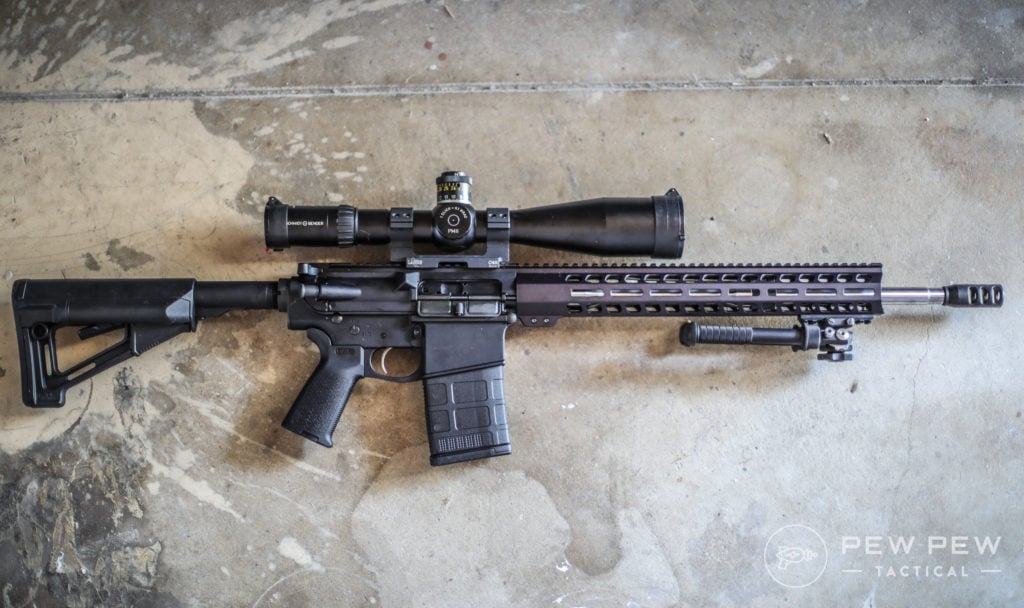There is no more popular long-range cartridge in the world than the 7.62x51mm or .308 Winchester.
Whether on the shelf in its .308 Winchester flavor, or the 7.62x51mm version, this cartridge has been in use since the 1950’s and it has carved out an enduring reputation with hunters, target shooters, the military, and law enforcement.
This legendary little cartridge still offers the same excellent ballistics, and is still available cheaper and more readily than any other round in its class.

We’re going to go over a little history followed by our favorite ammo picks.
But since ammo supplies are tight, here are some choices that are in-stock:
Although I would also check out Palmetto State Armory for the latest choices.
History of the .308
At one point in time, the equally venerable .30-06 was the rifle of choice for civilian hunters and distance shooters, as well as the US military.
This cartridge helped our grandparents defeat the Nazis, but problems quickly became evident in the close-in jungle fighting of the Korean War, especially when it became evident that .30-06s on fully-automatic were basically uncontrollably fired from the shoulder while standing up.
Also, there’s the simple logistical nightmare of having troops carry large amounts of very heavy ammunition through dense brush.
To combat this problem, the US government went on a search for a smaller, lighter cartridge that could be carried en masse, while retaining most of the desirable ballistics of the .30-06.


The 5.56×45 we all know and love would eventually come out of this, but the good ole 7.62x51mm NATO, first known as the .308 Winchester, came first.
You can read all about this process in the AR-15 vs Ar-10 discussion I did a while back.
Eventually, the standard M1 Garands were phased out, and the M14 was in, the 7.62×51 predecessor to the M16.
The US adoption of the M14, as well as the widespread use of the cartilage around the world in things like the FN FAL meant that the 7.62x51mm NATO was here to stay, and its enduring popularity as both a military and civilian round is in no small part because of this.
What Makes the .308 So Great?
First of all, the .308 Winchester is absurdly popular because of its popularity.
Don’t think about that too much, you’ll give yourself a headache.
What I mean is that the .308 beast is sort of self-sustaining at this point. It’s available everywhere because everyone uses it, and everyone uses it because its available everywhere.
You can find it anywhere firearms and sporting goods are sold, from your local Walmart to sporting goods stores and outfitters in any country that allows hunting with centerfire rifles, and that level of availability has ensured that the round has stayed popular ever since it was adopted by various militaries as a service cartridge…hence the 7.62x51mm NATO designation.


Second, there’s the versatility of the round.
It was originally chosen as a service cartridge because it excels at typical combat ranges (inside 500 yards), carries a significant amount of energy to the target thanks to the larger bullets that are possible thanks to the .30 cal chambering, and finally it’s relatively light recoil that makes it an incredibly shootable cartridge.
Choosing .308 Ammo
So, how do we pick from all those options?
Simple, we follow the Matthew Collins Patented System For Ammo Selection, or MCPSFAS (Help me come up with a better name in the comments).



Step One: Choose a Bullet Weight Based on Your Barrel Twist Rate
Step one, you have to look at your rifle. It’s important to match your bullet weight to your rifle, specifically the rifling in the barrel. This is measured as “twist rate” and will be expressed in a ratio like 1:15.
This means that the rifling in the barrel will complete one full rotation every 15 inches of barrel, and will thus impart one full spin to the bullet in that distance.
Now, if you’re just plinking at dirt clods with a service-grade Garand, I wouldn’t worry too much about this.
At a certain point, .308 is .308 and bullet weight doesn’t matter.
That said, if you’re looking to put lead down range accurately, here’s a general guideline for matching your barrel’s rifling to the ideal bullet weight.
- 1:15 twist: up to 150 grains
- 1:14 twist: 150 – 168 grains
- 1:12 twist: 168 – 170 grains
- 1:10 twist: 170 – 220 grains
- 1:8 twist: 220 grains or more
Again, this is just a general guideline, but it’s certainly a good starting point.
Sticking to this will ensure first and foremost that your rifling is “fast” enough to stabilize the size of projectile you’re using, and will also make sure you’re getting the most out of your barrel by using the largest projectiles it can reliably stabilize.
Of course, using a smaller bullet (which will be cheaper) in a faster twist rate than what’s listed is totally fine…you can’t exactly over-stabilize a bullet.
Most .308 barrels are 1-10 twist for this reason. Bullets over 220gr are rare, and the 1:10 twist means the rifle will stabilize almost all factory bullets.
Step 2: Choose a Bullet Type Based on Your Desired Activity
Are you shooting steel targets at 800 yards? You’ll probably want Open-Tip Match (OTM) ammo and a projectile that does a good job of balancing weight and velocity to combat things like wind drift and bullet drop.
Hunting? There are a huge number of hollowpoint hunting loads out there and it’s important to pick a load for the game you’re going after. This means researching bullet type (hollowpoint, polymer-filled, etc) as well as the recommended energy for the game you’re hunting, at the ranges you expect to be shooting.
Almost all factory hunting loads will have velocity and energy numbers on the box, but a ballistic calculator can help if not.
If you’re not going after any game other than steel targets, or you just want to punch holes in paper at close ranges, choose a good mid-range FMJ, or if you’re shooting steel at close range try and hunt down some frangible rounds online.
These rounds explode into metal powder on impact, and are much safer than other bullet types on steel…but still very much lethal. In fact, some folks recommend them for home defense because of the low risk of over penetration and ricochets.
Of course, you’ll notice a very conspicuous lack of “Home Defense Ammo” recommendations in this article for a reason…leave the .308 in the safe during a home invasion unless it’s literally all you have.
Finally, if you’re just going to be ripping through mags at the range or plinking at bottles and dirt clods, I’d suggest going with a cheap military surplus FMJ. You can get military-grade (not a synonym for quality, in this case) .308 like Wolf WPA Military Classic for around $.50/round, which is perfect for when you aren’t worried about accuracy, or you have a non-shooter buddy who wants to try your gun.
This has the added benefit of handicapping them if you’re target shooting and using better ammo for yourself…can’t have the newbies outshooting us experienced hands after all.
Step 3: Know Your Budget
Alright, this last one is optional but it’s important to note that good, factory match .308 ammo can be damn expensive.
Like, $2.50/round expensive. But most shooters aren’t going to need something like that. If you’re really trying to reach out to the limits of what the .308 can do, you should probably be handloading anyway, and with cheap brass and a variety of bullets available wherever reloading supplies are sold, handloading can be a great way to save money and get better performance.
Choosing Factory .308 Ammo
If you don’t want to get into all that reloading/handloading stuff, you still have tons of options for great factory ammo.
So many options in fact, that it can be quite difficult to choose, especially if you don’t have the time/money/energy to test multiple .308 offerings to find the best one.
That’s where I come in. I’ve tried about fifty flavors of .308 over the years, it is one of my favorite and most frequently used calibers, and these are the ones I recommend.
Best .308 Ammo For Hunting
Federal Premium Vital-Shok – 165 Grain Trophy Bonded Tip
Federal’s Premium Vital-Shok line is one of the most popular game rounds around and for good reason. The .308 Vital-Shok offering comes with a 165gr Trophy Bonded bullet with a polymer tip for superior aerodynamics and controlled expansion.
I’ve gotten two big whitetails and numerous hogs with this round, and I’d trust it for any medium game.
Remington Core-Lokt – 150gr Soft Point
Remington’s Core-Lokt line is a favorite of whitetail hunters, especially in the Southeastern US where we don’t have those long 400+ yard shots to worry about most of the time. The 150gr SP round is perfect for mid-sized games at close to mid-range, and is relatively accurate, even without the polymer tip.
It’s also a good bit cheaper and can be found on sale for under $.70/round at times.
Best .308 Ammo For Serious Target Shooting
Hornady Match 168gr
Hornady Match ammo is one of the most popular target rounds out there, and the 168gr .308 offering is fantastic for stretching the legs on your .308. This is my go-to factory load if I need to quickly pick up something for some range time where I actually care how I do.
I get sub-MOA groups out of this with a good rifle, and I would be happy to use it in a match if I didn’t have any handloads.
Federal Premium Sierra Match King Gold Medal
One of the best match loads on the market, Federal uses Sierra Match King bullets to make an outstanding factory loaded round.
I’ve been about to get half MOA groups with this ammo, that is mighty nice ammo for off the shelf!
What’s your take?
Best .308 Ammo For Plinking
Wolf Military Classic 168gr
Wolf Military Classic 168gr is a good approximation of a standard NATO military round found all around the world. This is a reliable round that is easy to buy cheap and stack deep. I have…way too much of this stashed in my apartment.
It’s a great round for the price and can be used for hunting, plinking, or target shooting depending on your needs. It’s a good practice round and the SP tip means it’ll do alright against soft targets as well.
Lake City 149gr FMJ 7.62x51mm
If you want real mil-spec ammo though, this is for you. Overrun ammo from Lake City can go up and down in price depending on military needs, but it’s normally decent price and is always great ammo!
Prvi Partizan Match 155gr HPBT .308
This is decidedly better than normal plinking ammo and is much closer to the good match grade stuff, but at a price that is still affordable. If you want to practise your match shooting, but not spend match shoot prices, this is a top choice!
PMC Bronze 147gr
PMC makes solid ammo in almost any caliber and their .308 stuff is no different! Great for plinking and holds good groups for its price.
MEN/Magtech 147gr
Solid ammo, but not impressive groups. Goes bang every time and is normally decent priced for brass, non-steel, non-bimetal. However, if you’re looking for tight groups from your plinking ammo – this might not be the best pick.
Parting Shots
That’s all she wrote folks. These .308 rounds are more than good enough to get you started.
We tested a lot of these ammo choices when we did our Aero Precision M5 Review, so if you want real-world shooting of these .308 rounds, take a look!
If you try any of these, make sure you let me know in the comments below! And if you have another factory load you prefer, make sure to drop that in the comments as well.











